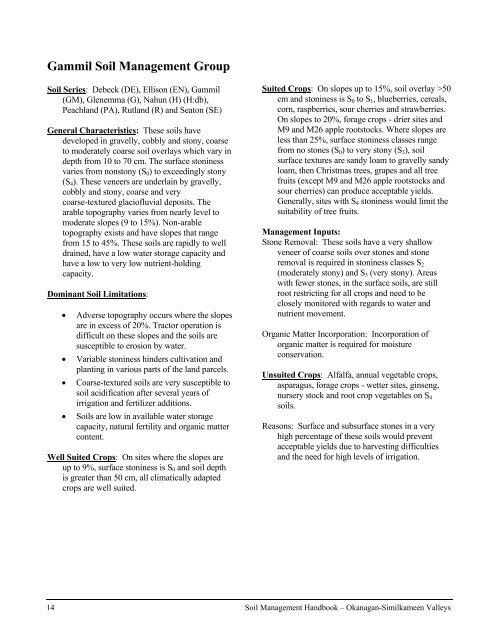Soil Management Handbook - Ministry of Agriculture and Lands
Soil Management Handbook - Ministry of Agriculture and Lands
Soil Management Handbook - Ministry of Agriculture and Lands
You also want an ePaper? Increase the reach of your titles
YUMPU automatically turns print PDFs into web optimized ePapers that Google loves.
Gammil <strong>Soil</strong> <strong>Management</strong> Group<br />
<strong>Soil</strong> Series: Debeck (DE), Ellison (EN), Gammil<br />
(GM), Glenemma (G), Nahun (H) (H:db),<br />
Peachl<strong>and</strong> (PA), Rutl<strong>and</strong> (R) <strong>and</strong> Seaton (SE)<br />
General Characteristics: These soils have<br />
developed in gravelly, cobbly <strong>and</strong> stony, coarse<br />
to moderately coarse soil overlays which vary in<br />
depth from 10 to 70 cm. The surface stoniness<br />
varies from nonstony (S0) to exceedingly stony<br />
(S4). These veneers are underlain by gravelly,<br />
cobbly <strong>and</strong> stony, coarse <strong>and</strong> very<br />
coarse-textured glaci<strong>of</strong>luvial deposits. The<br />
arable topography varies from nearly level to<br />
moderate slopes (9 to 15%). Non-arable<br />
topography exists <strong>and</strong> have slopes that range<br />
from 15 to 45%. These soils are rapidly to well<br />
drained, have a low water storage capacity <strong>and</strong><br />
have a low to very low nutrient-holding<br />
capacity.<br />
Dominant <strong>Soil</strong> Limitations:<br />
• Adverse topography occurs where the slopes<br />
are in excess <strong>of</strong> 20%. Tractor operation is<br />
difficult on these slopes <strong>and</strong> the soils are<br />
susceptible to erosion by water.<br />
• Variable stoniness hinders cultivation <strong>and</strong><br />
planting in various parts <strong>of</strong> the l<strong>and</strong> parcels.<br />
• Coarse-textured soils are very susceptible to<br />
soil acidification after several years <strong>of</strong><br />
irrigation <strong>and</strong> fertilizer additions.<br />
• <strong>Soil</strong>s are low in available water storage<br />
capacity, natural fertility <strong>and</strong> organic matter<br />
content.<br />
Well Suited Crops: On sites where the slopes are<br />
up to 9%, surface stoniness is S0 <strong>and</strong> soil depth<br />
is greater than 50 cm, all climatically adapted<br />
crops are well suited.<br />
Suited Crops: On slopes up to 15%, soil overlay >50<br />
cm <strong>and</strong> stoniness is S0 to S1, blueberries, cereals,<br />
corn, raspberries, sour cherries <strong>and</strong> strawberries.<br />
On slopes to 20%, forage crops - drier sites <strong>and</strong><br />
M9 <strong>and</strong> M26 apple rootstocks. Where slopes are<br />
less than 25%, surface stoniness classes range<br />
from no stones (S0) to very stony (S3), soil<br />
surface textures are s<strong>and</strong>y loam to gravelly s<strong>and</strong>y<br />
loam, then Christmas trees, grapes <strong>and</strong> all tree<br />
fruits (except M9 <strong>and</strong> M26 apple rootstocks <strong>and</strong><br />
sour cherries) can produce acceptable yields.<br />
Generally, sites with S4 stoniness would limit the<br />
suitability <strong>of</strong> tree fruits.<br />
<strong>Management</strong> Inputs:<br />
Stone Removal: These soils have a very shallow<br />
veneer <strong>of</strong> coarse soils over stones <strong>and</strong> stone<br />
removal is required in stoniness classes S2<br />
(moderately stony) <strong>and</strong> S3 (very stony). Areas<br />
with fewer stones, in the surface soils, are still<br />
root restricting for all crops <strong>and</strong> need to be<br />
closely monitored with regards to water <strong>and</strong><br />
nutrient movement.<br />
Organic Matter Incorporation: Incorporation <strong>of</strong><br />
organic matter is required for moisture<br />
conservation.<br />
Unsuited Crops: Alfalfa, annual vegetable crops,<br />
asparagus, forage crops - wetter sites, ginseng,<br />
nursery stock <strong>and</strong> root crop vegetables on S4<br />
soils.<br />
Reasons: Surface <strong>and</strong> subsurface stones in a very<br />
high percentage <strong>of</strong> these soils would prevent<br />
acceptable yields due to harvesting difficulties<br />
<strong>and</strong> the need for high levels <strong>of</strong> irrigation.<br />
14 <strong>Soil</strong> <strong>Management</strong> <strong>H<strong>and</strong>book</strong> – Okanagan-Similkameen Valleys
















